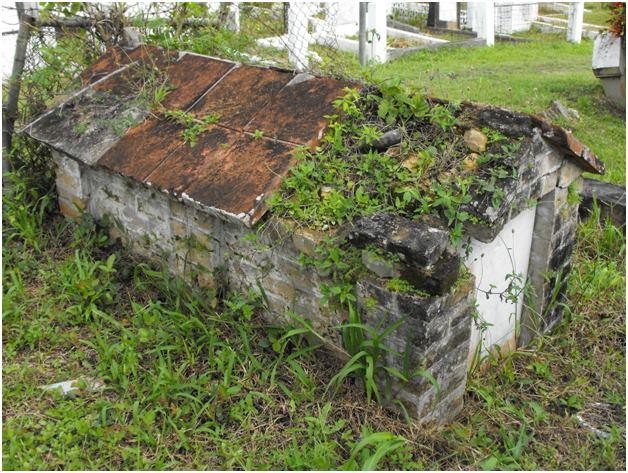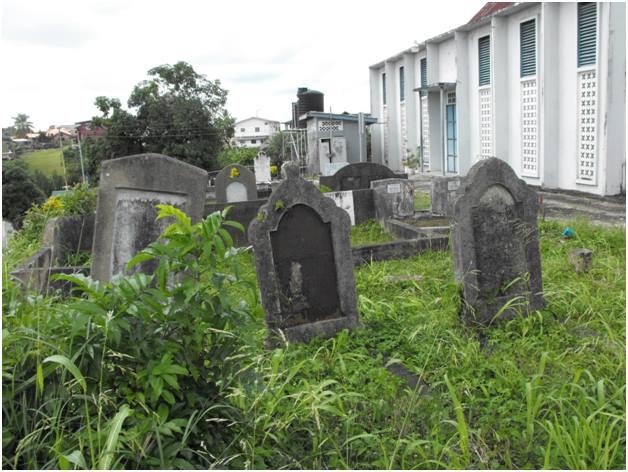|
In commemoration of the 142nd Anniversary Celebrations of Princes Town. Author : Angelo Bissessarsingh
In 2014, my friend and fellow historian, Richard Charan and I , embarked on an epic journey to find the remains of a long-forgotten 19th century sugar baron, Harry Darling, and in the process, unearthed stories of the Princes Town area that were documented In his parent paper and provided a valuable insight into how life was in those times. I assisted his researches and in the process stumbled upon some interesting gravestones in the unkempt and vandalized cemetery of the St. Stephen’s Anglican Church. They all stood in a forlorn cluster, away from the tombs of sugar planters, old parishioners and other prominent persons. The weathered and barely legible inscriptions were also noteworthy and showed some age, a couple examples being “In Memory of Frederick Maing, died 1st March 1905” and “In loving memory of our dear George Amow, died September 12th 1895 aged 38 “. Each marker, aside from the English epitaph,had Chinese script engraved on the marble tablets. Across town in the slightly better maintained graveyard of the Holy Cross Roman Catholic Church was another fascinating marker which used Scottish firebrick and Spanish clay tiles to create a rude pagoda which enclosed the remains of Louis Atteck who died on the 12th of September 1888. It is possible that Louis was an ancestor of the late Sybil Atteck whose artistic genius brought Trinidad and Tobago into the realm of modern art. Princes Town itself began life as the Mission of Savanna Grande. Founded in 1687 for the conversion of Amerindians to Christianity, it remained a sleepy village of First Peoples until the final disbanding of the mission in 1840. The Amerindians receded into history to make way for King Sugar. The Naparimas were the richest sugar lands in the island and Savanna Grande was its inland capital. Connected to the port of San Fernando by the island’s first railway in 1847 (the Cipero Tramroad), the settlement was a rip-roaring one where sugar planters mingled with ex-slaves, indentured immigrants from India and of course, the Chinese. The presence and industrious nature of the latter was noted by Charles Kingsley when he visited in 1870: “Then to church at Savanna Grande, riding, of course ; for the mud was abysmal, and it was often safer to ride in the ditch than on the road. The village, with a tramway through it stood high and healthy. The best houses were those of Chinese. The poorer Chinese find peddling employments and trade about the villages, rather than hard work on the estates; while they cultivate on ridges, with minute care, their favourite sweet potato. Round San Fernando, a Chinese will rent from a sugar-planter a bit of land which seems hopelessly infested with weeds. The Chinaman will take the land for a single year, at a rent, I believe, as high as a pound an acre, grow on it his sweet potato crop, and return it to the owner, cleared, for the time being, of every weed. The richer shopkeepers have each a store : but they disdain to live at it. Near by each you see a comfortable low house, with verandahs, green jalousies, and often pretty flowers in pots.and catch glimpses inside of papered walls, prints, and smart moderator-lamps, which seem to be fashionable among the Celestials. But for one fashion of theirs, I confess, I was not prepared. All that could be told was, that the richer Chinese take delight in thus bedizening their wives on high days and holidays ; not with tawdry cheap finery, but with things really expensive, and worth what they cost, especially the silks and brocades ; and then in sending them, whether for fashion or for loyalty's sake, to an English church.” With all the commerce around, some Chinese became cocoa proprietors as well as merchants. The lands to the north and east of Princes Town (so called after a Royal Visit in 1880) were divided into many small estates of five and ten acres. These could be easily planted and tended with the expert labour of Venezuelan cocoa panyols and in the cocoa boom of the late 19th and early 20th centuries, guaranteed a good income. The conversion of many Chinese to Christianity in the Prince Town area is proof of how rapidly these hardworking people integrated into Trinidadian society, dispelling the stereotype of the Orientals being silent and aloof. Today, there are still descendants of the many Chinese who once were a force to be reckoned with in the Naparimas.
0 Comments
Leave a Reply. |
T&T news blogThe intent of this blog is to bring some news from home and other fun items. If you enjoy what you read, please leave us a comment.. Archives
May 2025
Categories
All
|



 RSS Feed
RSS Feed